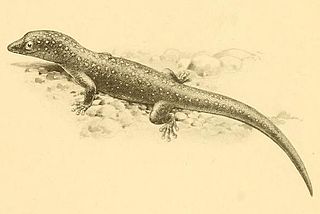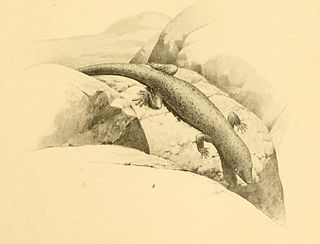
Sphaerodactylus is a genus of geckos from the Americas that are distinguished from other Gekkota by their small size, by their round, rather than vertical, eye pupils, and by each digit terminating in a single, round adhesive pad or scale, from which their name is derived. All species in this genus are rather small, but two species, S. ariasae and S. parthenopion, are tiny, and – with a snout-vent length of about 1.6 cm (0.63 in) – the smallest reptiles in the world.

Sphaerodactylus ariasae, commonly called the Jaragua sphaero or the Jaragua dwarf gecko, is the smallest species of lizard in the family Sphaerodactylidae.

Sphaerodactylus argus, also known commonly as the ocellated gecko, the ocellated sphaero, and the stippled sphaero, is a species of lizard in the family Sphaerodactylidae native to the Caribbean and surrounding regions. There are two recognized subspecies.

Sphaerodactylus notatus, also known as the Floridareef gecko or brown-speckled sphaero, is a small species of gecko native to Florida and the Caribbean.
Albert Schwartz was an American zoologist who worked extensively with the herpetofauna of Florida and the West Indies, and later with butterflies. One magazine article once dubbed him as one of the "Kings of West Indian Anole Taxonomy".

Aristelliger lar, also known as the Hispaniolan giant gecko and the spotted Caribbean gecko, is a species of lizard in the family Sphaerodactylidae. The species is endemic to the island of Hispaniola.
Armstrong's least gecko, also known commonly as the southern forest geckolet, is a species of lizard in the family Sphaerodactylidae. The species is endemic to the island of Hispaniola.
The peninsula least gecko is a species of lizard in the family Sphaerodactylidae. The species is endemic to the Dominican Republic.
Cochran's least gecko is a species of lizard in the family Sphaerodactylidae. The species is endemic to the Dominican Republic.

Cope's least gecko is a species of lizard in the family Sphaerodactylidae. The species is endemic to the West Indies.

Sphaerodactylus corticola, also known commonly as the central Bahamas sphaero or the Rum Cay least gecko, is a species of lizard in the family Sphaerodactylidae. The species is endemic to the Bahamas.

Darlington's least gecko is a species of lizard in the family Sphaerodactylidae. The species is endemic to the Dominican Republic.
The Cap-Haitien least gecko is a species of lizard in the family Sphaerodactylidae. The species is endemic to Haiti.
The Morne Dubois least gecko is a species of lizard in the family Sphaerodactylidae. The species is endemic to Haiti.
The Peravia least gecko is a species of lizard in the family Sphaerodactylidae. The species is endemic to the Dominican Republic.

The Pedernales least gecko is a species of lizard in the family Sphaerodactylidae. The species is endemic to the Dominican Republic.

Sphaerodactylus savagei, also known commonly as the Altagracia speckled sphaero or Savage's least gecko, is a small species of lizard in the family Sphaerodactylidae. The species is endemic to the Dominican Republic.
Sphaerodactylus storeyae, also known commonly as the Isle of Pines sphaero or the Los Canarreos geckolet, is a small species of gecko, a lizard in the family Sphaerodactylidae. The species is endemic to Isla de la Juventud in Cuba.
Sphaerodactylus thompsoni, also known commonly as Thompson's least gecko or the Barahona limestone geckolet, is a small species of lizard in the family Sphaerodactylidae. The species is endemic to Hispaniola.











